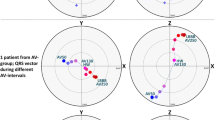Abstract
The present study aimed to assess whether impedance cardiography (IC) can correctly identify the optimal interventricular (VV) pacing interval in cardiac resynchronization therapy (CRT). Twenty four patients received a biventricular pacemaker and underwent IC for cardiac output (CO) measurements to identify the optimal VV interval. Invasive measurements of left ventricular (LV) dP/dtmax were used as a reference. During optimization the VV interval was changed with 20 ms steps from +80 (LV pre-excitation) to−80 ms (RV pre-excitation). The optimal VV interval was defined as the one that resulted in the highest LV dP/dtmax value and the highest CO obtained by IC, respectively. During simultaneous biventricular pacing both LV dP/dtmax and CO increased (mean 16.6% and 16.2%, respectively) as compared to baseline. Biventricular pacing with optimized VV intervals resulted in a further absolute increase of LV dP/dt max and CO (5.6% and 41.3%, respectively). The average decrease in LV dP/dtmax was 79.6 ± 51.6 mmHg/s when the optimal VV interval was programmed according to the IC measurements. Cross spectral analysis showed no correlation between the optimal VV intervals identified by the two methods (p > 0.05) and identical optimal VV intervals were identified in only six of the 24 patients. When broader VV time intervals were compared the correlation between the two methods was statistically significant (p = 0,0166). In conclusion, the use of IC for VV interval optimization is questionable since these optimized time intervals do not seem to correlate well with those obtained by measuring LV dP/dt.


Similar content being viewed by others
References
Cazeau, S., Leclercq, C., Lavergne, T., Walker, S., Varma, C., Linde, C., et al. (2001). Multisite Stimulation in Cardiomyopathies (MUSTIC) Study investigators. Effects of multisite biventricular pacingin patients with heart failure and intraventricular contraction delay. The New England Journal of Medicine, 344, 873–880.
Bristow, M. R., Saxon, L. A., Boehmer, J., Krueger, S., Kass, D. A., De Marco, T., et al. (2004). Comparison of Medical Therapy, Pacing and Defibrillation in Heart Failure (COMPANION) investigators. Cardiac resynchronization therapy with or without an implantable defibrillator in advanced chronic heart failure. The New England Journal of Medicine, 350, 2140–2150.
Cleland, J. F. G., Daubert, J. C., Erdmann, E., Freemantle, N., Gras, D., Kappenberger, L., et al. (2005). Cardiac resynchronization study (CARE-HF) investigators. The effect of cardiac resynchronization on morbidity and mortality in heart failure. The New England Journal of Medicine, 352, 1539–1549.
Birnie, D. H., & Tang, A. S. (2006). The problem of non-response to cardiac resynchronization therapy. Current Opinion in Cardiology, 21, 20–26.
Sogaard, P., Egeblad, H., Pedersen, A. K., Kim, W. Y., Kristensen, B. O., Hansen, P. S., et al. (2002). Sequential versus simultaneous biventricular resynchronization for severe heart failure: evaluation by tissue Doppler imaging. Circulation, 106, 2078–2084.
Perego, G. B., Chianca, R., Facchini, M., Frattola, A., Balla, E., Zucchi, S., et al. (2003). Simultaneous vs sequential biventricular pacing in dilated cardiomyopathy: an acute hemodynamic study. European Journal of Heart Failure, 5, 305–313.
Van Gelder, B. M., Bracke, F. A., Meijer, A., Lakerveld, L. J., & Pijls, N. H. (2004). Effect oh optimizing the VV interval on left ventricular contractility in cardiac resynchronization therapy. The American Journal of Cardiology, 93, 1500–1503.
Bax, J. J., Ansalone, G., Breithardt, O. A., Derumeaux, G., Leclercq, C., Scalij, M. J., et al. (2004). Echocardiographic evaluation of cardiac resynchronization therapy: ready for routine clinical use? A critical appraisal. Journal of the American College of Cardiology, 44, 1–9.
Butter, C., Stellbrink, C., Belalcazar, A., Villalta, D., Schlegl, M., Sinha, A., et al. (2004). Cardiac reshynchronization therapy optimization by finger plethysmography. Heart Rhythm, 1, 568–575.
Braun, M. U., Schnabel, A., Rauwolf, T., Schulze, M., & Strasser, R. H. (2005). Impedance cardiography as a non-invasive technique for atrioventricular interval optimization in cardiac resynchronization therapy. Journal of Interventional Cardiac Electrophysiology, 13, 223–229.
Heinroth, K. M., Elster, M., Nuding, S., Schlegel, F., Christoph, A., Carter, J., et al. (2007). Impedance cardiography: a useful and reliable tool in optimization of cardiac resynchronization devices. Europace, 9, 744–750.
Drazner, M. H., Thompson, B., Rosenberg, P. B., Kaiser, P. A., Boehrer, J. D., Baldwin, B. J., et al. (2002). Comparison of impedance cardiography with invasive hemodynamic measurements in patients with heart failure secondary to ischemic or nonischemic cardiomyopathy. The American Journal of Cardiology, 89, 993–995.
Belardinelli, R., Ciampani, N., Costantini, C., Blandini, A., & Purcaro, A. (1996). Comparison of impedance cardiography with thermodilution and direct Fick methods for non-invasive measurement of stroke volume and cardiac output during incremental exercise in patients with ischemic cardiomyopathy. The American Journal of Cardiology, 77, 1293–1301.
Albert, N. M., Hail, M. D., Li, J., & Young, J. B. (2004). Equivalence of the bioimpedance and thermodilution methods in measuring cardiac output in hospitalized patients with advanced, decompensated chronic heart failure. American Journal of Critical Care, 13, 469–479.
Ovsyshcher, I., Zimlichman, R., Katz, A., Bondy, C., & Furman, S. (1993). Measurements of cardiac output by impedance cardiography in pacemaker patients at rest: effects of various atrioventricular delays. Journal of the American College of Cardiology, 21, 761–767.
Kindermann, M., Frohlig, G., Doerr, T., & Schieffer, H. (1997). Optimizing the AV delay in DDD pacemaker patients with high degree AV block: mitral valve doppler versus impedance cardiography. Pacing and Clinical Electrophysiology, 20, 2453–2462.
Author information
Authors and Affiliations
Corresponding author
Rights and permissions
About this article
Cite this article
Sciaraffia, E., Malmborg, H., Lönnerholm, S. et al. The use of impedance cardiography for optimizing the interventricular stimulation interval in cardiac resynchronization therapy—a comparison with left ventricular contractility. J Interv Card Electrophysiol 25, 223–228 (2009). https://doi.org/10.1007/s10840-009-9367-x
Received:
Accepted:
Published:
Issue Date:
DOI: https://doi.org/10.1007/s10840-009-9367-x




